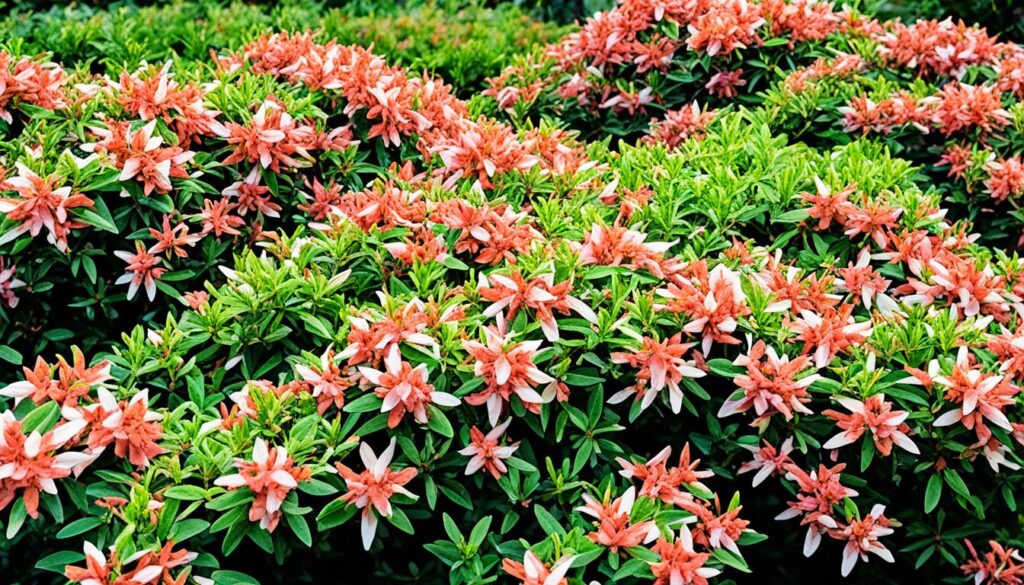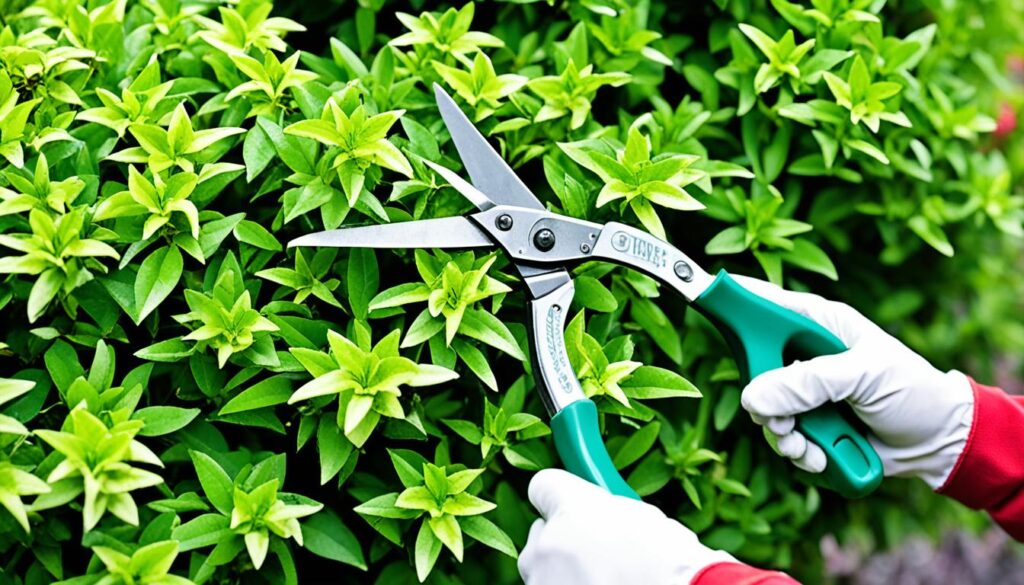
Welcome to the world of abelias, where colors and scents make your garden beautiful. These plants are great for making your garden look better with their green leaves and flowers. They’re perfect for both new and experienced gardeners.
This article will teach you about abelias and how they can improve your garden. You’ll learn about different types of abelias and how to take care of them. We’ll cover watering, pruning, and other important tips to help your abelias grow well.
Let’s dive into how to make your garden beautiful with abelias. Get ready to make your garden the talk of the town!
Understanding Abelias: Characteristics and Benefits
Abelias belong to the Caprifoliaceae family. They are great for gardeners looking for versatile flowering shrubs. These plants bloom for a long time and do well in many conditions. They are a top choice for garden lovers. Knowing what makes abelias special can help you enjoy them more.
What Are Abelias?
Abelia plants are flowering shrubs that come in different sizes and shapes. They are known for their tubular flowers that attract bees and butterflies. They also have shiny leaves. You can find both compact and glossy abelias, perfect for many garden styles.
Key Features of Abelia Plants
Abelias are adaptable and can grow in various places. They do well in full sun or partial shade. They also need little care once they are planted. Here are some key features:
- Long blooming season with delicate flowers
- Variety of growth forms, from compact to sprawling
- Glossy green leaves that provide year-round interest
- Attraction to butterflies and other pollinators
Advantages of Growing Abelias in Your Garden
Growing abelias has many benefits. They add color and texture to your garden. They are easy to care for, giving you more time to enjoy your garden. For more tips on growing these plants, check out this guide. Abelias can be used in many ways in your garden:
| Benefit | Description |
|---|---|
| Ornamental Value | Beautiful blooms and foliage enhance visual appeal. |
| Low Maintenance | Requires minimal care once established. |
| Wildlife Attraction | Flowers attract beneficial pollinators such as bees and butterflies. |
| Versatility | Can be used in hedges, borders, or as standalone features. |
Best Varieties of Abelia Shrubs for Your Landscape

Choosing the right abelia shrubs can make your landscape look better. They add color and fragrance to your garden. Here are some top abelia varieties for your outdoor space.
Popular Abelia Varieties to Consider
Here are some top picks:
- Glossy Abelia: It has shiny green leaves and smells nice. It does well in full sun or partial shade.
- Kaleidoscope Abelia: It has colorful leaves that change with the seasons. It’s a great choice for any garden.
- Edward Goucher Abelia: This one is small with fragrant pink flowers. It attracts bees and butterflies.
- Confetti Abelia: It has leaves with bright colors, adding texture to your garden.
- Rose Creek Abelia: Great for big plantings or hedges. It grows slowly but is very strong.
Choosing the Right Abelia for Your Garden Style
Think about height, leaf color, and when it blooms when picking abelia varieties. Make sure it fits your garden design. Abelias are great for many uses, from foundation plants to mixed borders. They grow in different soils and need moderate water.
Adding abelias to your garden makes it more beautiful and attracts wildlife. Their scent makes evenings special. For more gardening tips, check out Greenscapes Garden.
Choosing the right abelia shrubs can turn your garden into a beautiful spot. They’re easy to care for and can handle drought. Knowing about the different types helps you pick the best for your garden.
Abelias: Ideal Growing Conditions and Locations

For your abelias to bloom well and grow strong, you need to know the best conditions for them. This part talks about what they need, like sunlight, soil, and climate.
Sunlight Requirements for Abelias
Abelias love full sun and need at least six hours of sunlight a day. This helps them grow strong and flower a lot. Putting your plants in the right sunlight spot is key to good care and lots of flowers.
Soil Types and pH Levels for Healthy Abelia Growth
Abelias do best in soil that drains well but holds moisture. They like a pH between 6.0 and 7.0 for their roots. Avoid heavy clay soils by adding organic matter to help with drainage and nutrients. Keeping an eye on your soil is important for taking good care of your abelias.
Climate Considerations for Successful Abelia Cultivation
Abelias can grow in many climates but do great in places with mild winters and warm summers. They like moderate rain and can handle some drought once they’re set. Giving them the right climate helps them look their best and stay strong. For more tips on planting in your garden, see this resource.
| Growing Condition | Ideal Requirements |
|---|---|
| Sunlight | Minimum 6 hours of direct sunlight |
| Soil Type | Well-draining soil, slightly acidic to neutral |
| pH Level | 6.0 to 7.0 |
| Climate | Mild winters, warm summers, moderate rainfall |
Care for Your Abelia Plants: Essential Tips
Learning how to care for your abelia plants is key to their health and beauty. This part talks about watering, fertilizing, and managing pests to help your abelias flourish in your garden.
Watering Guidelines for Abelias
New abelias need regular watering to grow strong roots. Try to give them about an inch of water each week. Adjust this if it’s very hot or cold.
If it’s really hot, you might need to water more often. Once they’re grown, abelias can handle drought well. But, watering them during dry times helps a lot.
Fertilizing Schedules and Nutritional Needs
To keep abelias healthy and blooming, fertilize them twice a year. Do this in the spring before they start growing, and again when they’re in bloom. Use a slow-release fertilizer that’s good for acidic plants.
Pest and Disease Management for Healthy Abelias
Aphids are common pests for abelias. Check your plants often to spot these pests early. If you find them, you can use water, neem oil, or insecticidal soap to get rid of them.
Abelias don’t usually get many diseases. This makes them easy to care for.
| Care Aspect | Details |
|---|---|
| Watering Frequency | 1 inch per week; increase during hot spells |
| Spring Fertilization | Before growth begins; use acidic slow-release fertilizer |
| Flowering Phase Fertilization | Apply fertilizer as flowering starts |
| Pest Management | Monitor for aphids; treat with water, neem oil, or insecticidal soap |
| Disease Incidence | Generally low; no specific diseases common |
Abelia Pruning: Best Practices for Lush Growth

Pruning is key to keeping abelia plants healthy and looking great. Knowing how to prune abelia plants helps with their looks and blooms. This part talks about the best times to prune, how to do it right, and what mistakes to avoid.
When to Prune Your Abelia Shrubs
The best time to prune abelia is in late winter to early spring. Prune just before new growth starts. This helps new buds grow, making your plants bloom more.
Pruning at this time follows best practices. It keeps your plants strong all season.
Pruning Techniques to Enhance Flowering
Using the right pruning methods boosts your abelias’ flowers. Start by cutting dead or damaged branches. This improves air flow and lets more light in.
Then, thin out the inside branches to help new growth. Don’t cut too much, as this can reduce blooms. These steps keep your plant looking good and blooming well.
Common Mistakes to Avoid When Pruning Abelias
Many gardeners make mistakes when pruning that hurt their abelias. Some common errors include:
- Pruning too late, which cuts off blooms.
- Cutting too much foliage, weakening the plant.
- Not cleaning tools before use, which spreads disease.
Knowing these mistakes helps you prune your abelia right. For more gardening tips, check out this link.
Landscaping with Abelias: Creative Ideas
Using abelias in your garden can be very creative. They are great for making green hedges that keep things private. You can also use them as eye-catching spots in your garden.
These plants attract butterflies and bees, which is good for your garden. You can mix them with taller plants like the Gold Star Pittosporum or Dogwoods. This makes your garden look better and helps many kinds of plants live together.
Adding plants like Lantana and Geraniums with abelias means your garden will look great all year. It becomes a lively place.
Adding statues or decorative pottery to your garden is a good idea. It makes your garden feel cozy and inviting. For more tips on using abelias in your garden, check out this resource.



